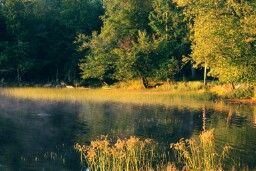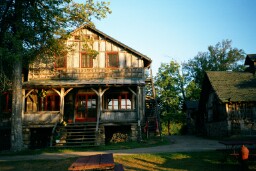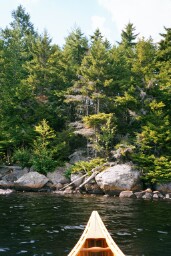 Great Camp Sagamore
Great Camp Sagamore
Where the Gilded Age
meets the North Woods
Nestled on a peninsula jutting out into its own private lake (Sagamore Lake) in the heart of New York's justly famous Adirondack region, Great Camp Sagamore was built by William A. Durant in 1897; it then passed into the hands of Alfred Vanderbilt in 1901, who kept it until he was killed when the Lusitania was torpedoed in 1915, two years before the U.S. entry into World War One. It remained in the family as their summer retreat until 1954. Designed to carefully create the illusion of "roughing it" for its wealthy owners and their guests, Durant's "Great Camps" -- and their successors by other builders -- were, as cultural historian Michael Wilson points out, the "first American architecture to say, 'we belong' in nature."
I had the pleasure of visiting Sagamore toward the end of this past summer, 2002, interviewing for a possible position there. Although that position didn't work out, I was quite taken by the rustic magnificence of Sagamore, one of the finest of the Adirondack Great Camps, and even more the quiet beauty of its wilderness setting... a "wilderness" less that two hours, by modern conveyance, from the heart of New York City. The following "picture essay" is from photos taken at Sagamore during my stay there, and is underaken with great fondness both for the beauty of this magical place, and for the efforts of its builders and owners to be -- or at least to appear -- "at home" in this mystical and magnificent landscape.
| |
|
|
| |
|
|
| |
|
|
| |
|
|
Sagamore Lake Dawn, Reprise...
When the loons are calling out of the mist, and the "white horses" gallop out of the bays toward the rising sun -- or again, as the sun sets, and the dusk deepens, and the barred owls begin to call -- a northern lake is far more than rocks, water, and trees, however beautiful these things, by themselves, may be. It is a seat of Mystery, a place of wonder, which transcends the limitations of time and space to touch the timeless, the eternal, the ethereal.
At such times, a person may be transported out of himself, and into the heart of what Sigurd Olson called "the singing wilderness." I was blessed to hear that singing, in the voices of loons and owls, in the lapping of water against rocks, in the sighing of wind through spruce and birch, in the dance of the stars far above the darkened lake, and in the silences beyond sound, at Sagamore. And for that, I am deeply grateful.
All of the pictures on this page were taken by Thomas H. Harbold and remain the intellectual property of the photographer, who asserts copyright over them. None of these photographs may be saved, downloaded, copied, altered, sent via e-mail or any other means, or posted on any other website, bulletin board, etc., without the written permission of the photographer.












